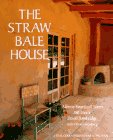FIVE: Environmentally friendly building styles
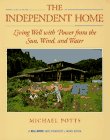 The
Independent Home : Living Well With Power from the Sun, Wind, and
Water (A Real Goods Independent Living Book)
The
Independent Home : Living Well With Power from the Sun, Wind, and
Water (A Real Goods Independent Living Book)
by Michael Potts, John Schaeffer (Designer)
Editorial Reviews
Whether you already own a home or plan to build one, The
Independent Home will show you how to transform it into an
energy-efficient, comfortable, self-sustainable home of the
future-- right now. Michael Potts's home has been featured on
the ABC evening news as an example of the sane approach to simple
living; he demonstrates how one can live well, save money, save
resources, and still retain modern conveniences and comfort. The
Independent Home proves that it is not necessary to live in
mud-floored huts and cook brown rice over a campfire to go back
to the land
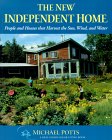 The New
Independent Home : People and Houses That Harvest the
Sun
The New
Independent Home : People and Houses That Harvest the
Sun
Editorial Reviews
The author, Michael Potts ,
December 18, 1999: My book helps folks take control of their
energy destiny
It took me 20 years to get ready to write my book -- tinkering,
visiting, figuring arcane technology out -- and then another 6
years to get the book right. Independent homesteaders offer us
all lessons on using our energy better. On-the-gridders waste
half the energy they buy, while we who carefully harvest every
electron, teaspoon of water, and therm of heat, strive to waste
as little as possible. This work reconnects us with the planet in
unexpected ways. There are important lessons in my book about
phantom loads, free energy sources, and small habit changes that
have helped many "on-the-gridders" reduce their energy
bills by 30% - 60% -- enough to pay for their energy improvements
with enough left over to buy a new copy of my book (and give it
to a friend) every month!
Get a leg up on the first Little Pig with The Straw Bale House, your guide to inexpensive, durable, earth-friendly construction that will stand up to much more than the Big Bad Wolf. Authors Athena Swentzell Steen and Bill Steen founded the Canelo Project, which promotes innovative building; David Bainbridge is a California restoration ecologist; and David Eisenberg is an alternative-materials builder who pioneered straw bale wall testing. Between them, they have encyclopedic knowledge of their subject. The book is comprehensive, broadly covering why and how to build with straw and then focusing on the details, which are both intellectually and aesthetically delightful. Beside being cheap, clean, and lightweight, straw also provides advantages like energy efficiency and resistance to seismic stresses. For the nervous Martha Stewart types, there are scads of black-and-white and color plates of strikingly beautiful interiors and exteriors from New Mexico to southern France. Both new and experienced builders will appreciate the clear, simple instructions and diagrams, as well as practical explanations for dealing with building codes and insurers. The Straw Bale House shows us advantages so numerous and dramatic that you'll wonder why we ever moved on to sticks and bricks. --Rob Lightner. From Book News, Inc.; A guide to building living structures with straw bales. Covers benefits of building with straw bales, safety concerns, building codes, and insurance, and offers techniques for building walls, windows, doors, foundations, roofs, floors, and plastering the straw walls. Includes b&w photos demonstrating building techniques, and color photos of finished homes and interiors. Annotation copyright Book News, Inc. Portland, Or.
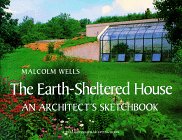 The
Earth-Sheltered House : An Architect's Sketchbook (Real Goods
Solar Living Book)
The
Earth-Sheltered House : An Architect's Sketchbook (Real Goods
Solar Living Book)
by Malcolm Wells,
Editorial Reviews
The striking common
sense of the author's perspective on design and the building
process is based on millennia of use of earth-sheltered homes by
animals and humans, using the earth to warm in winter and cool in
summer. A cartoon on the book jacket summarizes Wells's
perspective. One panel is called "20th Century," and
has four steps of traditional building: love nature, kill it,
build building, plant grass. The second panel, called "21st
Century," says: love nature, leave it alone, find ruined
land, build underground, restore natural habitat. Wells's
remarkable and imaginative architectural drawings, sketches, and
landscaping and structural design plans are surrounded by his
handwritten commentary about Earth-friendly building and design,
cryptic remarks and humorous asides that make this book a
pleasure to browse or read cover to cover. He offers a
breathtaking assortment of some of the most creative and unusual
home and building designs ever assembled in one book;
site-appropriate structures for both urban and rural settings;
and delightfully imaginative, dramatic, simple, and highly
complex buildings for all purposes. Some are fully underground
structures, some partially earth-sheltered, but all make the best
use of light sources, designed to benefit from the sun and
seasonal changes, and to protect or restore the natural habitat
around and above them. Wells's designs seem almost fanciful,
but are indeed based on practical considerations and currently
usable techniques and materials, helping open up a whole new
concept of building based on one of the oldest known: caves and
burrows. These are "caves and burrows" of soaring
imagination and creative, 21st century brilliance. --Mark A.
Hetts
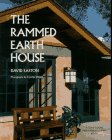 The
Rammed Earth House (Real Goods Independent Living
Book)
The
Rammed Earth House (Real Goods Independent Living
Book)
by David Easton, Cynthia Wright (Photographer), David
Eaton
Editorial Reviews
The beauty and grace
of rammed earth construction is described in fascinating detail
by David Easton. The photographs of different structures, both
modern and ancient, by Cynthia Wright, create a breathtaking
glimpse into a building technique that is as old as human
history, but exactly suitable for today's resource-conscious
and environmentally friendly building needs. Trees may be getting
a bit scarce these days, but there's no current shortage of
dirt, the main component of rammed earth homes. From such a
prosaic material, gold has been spun in these timeless, graceful,
and nearly indestructible homes and buildings.
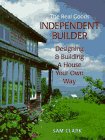 Independent Builder : Designing & Building a
House Your Own Way (Real Goods Independent Living
Books)
Independent Builder : Designing & Building a
House Your Own Way (Real Goods Independent Living
Books)
by Sam Clark
Subtitled "Designing and
Building a House Your Own Way," this is the book for anyone
thinking about building their own home. It is comprehensive,
detailed and covers subjects I have never before seen covered in
home building books, like how to make a small house seem bigger,
incorporating ergonomics and accessibility, doing your own
drawings and scale models, making contracts that work, and
working effectively with professional designers and builders.
With detailed diagrams and photographs, this is the most thorough
overall guide to building your own home I have ever seen (and
I've seen a lot!). The author, Sam Clark , February 25, 2000
Strengths of "The Independent Builder"...My book is a
comprehensive 500 page treatment on house building, a basic
manual useful to owner-builders, families working with
professionals, and to builders. I think its strengths
include: Technical information, presented clearly, based on
underlying principles. For example, along with tables for beam
sizes, I give the concepts and formulas so you can figure sizes
yourself. Other examples: heat loss, sound isolation, sun angles.
I think if you understand the principles, you can design
more
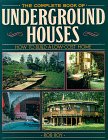 Complete
Book of Underground Houses : How to Build a Low-Cost
Home
Complete
Book of Underground Houses : How to Build a Low-Cost
Home
by Robert L. Roy, Rob Roy
A ccording to Roy, underground or
"earth-sheltered" houses are unexpectedly livable.
Judging by his book's attractive pictures, that's easy to
believe. The house he bases his point-by-point guide on is indeed
a showplace. Its homey touches are just that, though, and
Roy's main concern is creating such a house, from drawing up
the plans to surveying the site to the actual building. Roy's
instruction is insightful and comprehensive; for example, he
writes that he has poured the four-inch cement floor over the
waste plumbing in all the houses he has built and has had no
trouble yet, but he also suggests another strategy for those
leery of not being able to get at the pipes in an emergency.
Throughout, he covers construction and installation details that
are extremely important for nonprofessionals brave enough to
undertake building their own homes. Mike Tribby From Book News,
Inc.
Instead of marring a grassy knoll or field with the construction
of a conventional house, you could design and build an
environmentally sound underground or earth-sheltered home. Roy,
director of the Earthwood Building School, provides detailed
instructions, from choosing a piece of property to excavating and
building a home from top to bottom, with case studies, photos and
diagrams, and further resources.
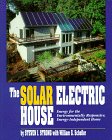 The
Solar Electric House : Energy for the Environmentally-Responsive,
Energy-Independent Home
The
Solar Electric House : Energy for the Environmentally-Responsive,
Energy-Independent Home
by Steven J. Strong
THE most comprehensive solar electric book available, January 30, 1999 . Reviews: Steven Strong's book "The Solar Electric House" is the most comprehensive book available regarding the application of solar-generated electricity (photovoltaics). The book is well organized, well written, and easy to understand. Although this book was first printed in 1987, it is amazingly current today (1999). I have been using this book since 1987 when I build my stand-alone PV-powered home in Prescott Arizona, and referred to Mr. Strong's book on a regular basis during design and construction of the solar-electric system. I still use this book today -- as the primary textbook in two classes that I teach at Arizona State University: "Introduction to Solar Energy and Photovoltaics" and "Photovoltaic System Design".
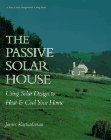 The
Passive Solar House (Real Goods Independent Living
Books)
The
Passive Solar House (Real Goods Independent Living
Books)
by James Kachadorian
This book offers a technique for building homes that heat and cool themselves in a wide range of different climates, using ordinary building materials available anywhere and with methods familiar to all building contractors and many do-it-yourselfers. A formerly patented design for author James Kachadorian's Solar Slab heat exchanger is now available for the use of anyone motivated by the desire to build a house that needs a backup furnace or air conditioner rarely if ever. This is a building book for the next century. Applicable to a diversity of regions, climates, budgets, and styles of architecture, Kachadorian's techniques translate the essentials of timeless solar design (siting a home in harmony with nature, using windows as solar collectors, achieving year-round comfort by balancing good insulation with healthy supplies of fresh air) into practical wisdom for today's new generation of solar builders.
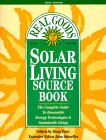 The Real
Goods Solar Living Sourcebook : The Complete Guide to Renewable
Energy Technologies and Sustainable Living ( Real Goods Solar
Living Source book)
The Real
Goods Solar Living Sourcebook : The Complete Guide to Renewable
Energy Technologies and Sustainable Living ( Real Goods Solar
Living Source book)
by John
Schaeffer (Introduction), Douglas M. Pratt
(Editor)
Editorial Reviews
I
t is arguably a form of cultural
insanity that industrial civilizations constantly bathed by free
and clean energy from the sky (the sun and the wind) continue to
depend upon dirty and limited chemical fuels that poison the
people, their foods, and the land upon which they
depend.
Happily, this comprehensive
sourcebook provides those of you with foresight a way out of this
madness; it includes products ranging from simple energy-saving
devices such as compact fluorescent lights to home-scale
energy-harvesting systems that utilize the sun, wind, and water
to make electricity for people living "off-the-grid."
Chapters focus on Independent Living, Land, Shelter, Harvesting
Energy, Managing Energy Systems, Heating and Cooling, Water,
Energy Conservation, the Nontoxic Home, Home and Market
Gardening, Mobility and Electric Vehicles, and Livelihood and
Learning. Committed to selling only products that promote
environmental responsibility at an honest value, The Real Goods
Trading Company is one of the fastest-growing companies in
America. Many of the products listed in another of my favorite
sites, the Millennium Whole Earth Catalog , can be
purchased by mail from "Real Goods".
Whole Earth Review
The Sourcebook remains the best introduction to energy-efficient
technology for common folks.
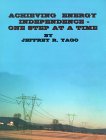 Achieving
Energy Independence - One Step at a Time
Achieving
Energy Independence - One Step at a Time
by Jeffrey R. Yago
A must have first text for any homeowner wanting to install a back up power system for their home or home business. Addresses new ways to prepare for power outages including Y2K, brownouts, storm outages, and rolling blackouts. Step by step guide to become independent of the utility grid. Answers all installation questions about solar photovoltaic systems, generators, battery inverters, wind turbines, and battery banks, including wiring diagrams and safety issues.
About the Author
Jeffrey Yago is a licensed professional engineer and certified
energy manager, with over 25 years experience in the design of
solar and backup power systems throughout the United States and
Europe. He has authored two prior texts related to energy
conservation and installation guidelines for heating and cooling
systems, and his technical articles have appeared in national
publications including HomePower Magazine, Mother Earth News, and
Solar Engineering.
 Passive
Solar House Basics
Passive
Solar House Basics
by Peter Van Dresser
P ASSIVE SOLAR HOUSE BASICS, by Peter van Dresser. Anyone who has visited a solar adobe home on a cold winter day has felt the warmth and comfort of its natural radiant heat. PASSIVE SOLAR HOUSE BASICS lays out in plain language what an owner-builder and designer will need to know about siting, designing, constructing, and living in a solar adobe home. Van Dresser's text and pictures provide a beginner's course in adobe construction and passive solar heat collection, including suggestions for natural heat circulation and heat storage in thermal mass. Included are sample house plans, ideas for solar hot water heaters, and plans-to-scale for solar crop dryers. The simple means he has developed for economically harnessing the energy of the sun in an energy-efficient home are easily within the grasp of the average home owner, home builder, or solar enthusiast. In 1958 solar pioneer Peter van Dresser built his first solar heated house, one of the first in the United States. First published as HOMEGROWN SUN-DWELLINGS, PASSIVE SOLAR BASICS was the outgrowth of a solar demonstration project. Peter van Dresser is the author of LANDSCAPE FOR HUMANS, as well as numerous articles about solar energy and rural life.
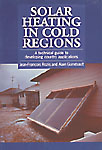 Solar
Heating in Cold Regions
Solar
Heating in Cold Regions
by Jean-Francois Rozis
A technical guide, written
for developing countries but no less relevant in the west, for
climates where the average annual temperature is lower than
10ºC. Contains examples of typical installations and how to
size them. The examples are low maintenance and also introduce
income generating activities. Anyone living in PA, NY, NJ, CT,
VT, MA, or any of the northwestern states would definitely enjoy
the practical solutions offered for solar heating your
home.168pp
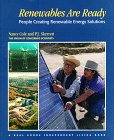 Renewables
Are Ready : People Creating Renewable Energy Solutions (A Real
Goods Independent Living Book)
Renewables
Are Ready : People Creating Renewable Energy Solutions (A Real
Goods Independent Living Book)
b
y Nancy Cole, P. J. SkerrettTells
the inspirational stories of American who have made renewable
energy a reality in their own communities. Renewables are Ready
is the first book to document the wide range of renewable energy
efforts currently underway.
All of the ideas presented in the book can be implemented in a city, town or neighborhood through individual and group initiatives. Examples include the residents of Austin, Texas, who have turned their city into a national showplace for energy conservation and the use of renewables. 256pp
 THE WATER
CRISIS
THE WATER
CRISIS
Julie Stauffer
S tarting with the
history of water and ending with a look to the future, this book
considers problems caused by urban sewage, intensive farming,
acid rain and heavy metals.
Sections on prevention and solutions, includes diagrams and descriptions of the latest treatment techniques and how to use them. 176pp
by Duncan McClaren (Editor), Simon Bullock
(Editor), Nusrat Yousuf (Editor)TOMORROW’S
WORLD
A valuable read for those interested in sustainability. One of
the few books which both asks and answers the question of what
exactly we need to live a sustainable lifestyle. Useful for those
involved in political or community work, such as Agenda 21, or
for those simply interested in what we need to do in order to
survive for the future. 382pp
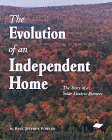 The
Evolution of an Independent Home : The Story of a Solar Electric
Pioneer
The
Evolution of an Independent Home : The Story of a Solar Electric
Pioneer
by Paul Jeffrey Fowler
Editorial Reviews
T he New
Sunpaper, September 1995
Reading this book is like having a good friend tell you how he
did it because he hopes his experience will help you to decide to
do it yourself.....More than any technical manual could,
Fowler's book invites the reader to realize the ideals of
building an earth friendly house while encouraging them to
appreciate the many facets of what it takes to get the job
done.
Rhode Island Solar Energy
Association, Summer 1995
This book is for those who want to know how to build a passive
solar house powered by a solar electric system. It is a working
diary, interestingly written.....and easily understood
.
 Consumer
Guide to Solar Energy : Easy and Inexpensive Applications for
Solar Energy
Consumer
Guide to Solar Energy : Easy and Inexpensive Applications for
Solar Energy
by Scott Sklar,
Consumer Guide to Solar Energy., January 7, 2001 Review: This book was quite broad in covering many issues of solar energy. From Heating your house, pool, food, and even providing electricity. It also gave many contacts to seek further information about legal issues, financial incentives, or more information. This is a great beginners book to learn about Solar energy if you know little to nothing about it. If you are looking for detailed information on a particular aspect of solar energy, however, this is not the book. It's a good little reference book though, especially for the price.
 The Fuel
Savers : A Kit of Solar Ideas for Your Home, Apartment, or
Business
The Fuel
Savers : A Kit of Solar Ideas for Your Home, Apartment, or
Business
by Bruce Anderson, (Editor)
Editorial Reviews
P aul
Hawken, Author "Growing a Business"
A most practical, step-by-step guide for individuals and
homeowners to one of the most important issues we face: reducing
our wasteful dependence on fossil fuels.
Eric Heitz--The Energy
Foundation
The Fuel Savers is truly solar made simple--a friendly guide to
solar energy for homes with lots of pictures and good advise.
Bruce Anderson's recommendations make sense for the
pocketbook and for the environment.
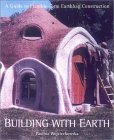 Building
With Earth : A Guide to Flexible - From Earthbag
Construction (The Real Goods Solar Living Book)
Building
With Earth : A Guide to Flexible - From Earthbag
Construction (The Real Goods Solar Living Book)
by Paulina Wojciechowska, Bill, Athena Steen
Paperback - 176 pages illustrate edition (May 2001)
Chelsea Green Pub Co; ISBN: 1890132810 ...As with most of the
books illustrated, this one is a winner. For the first time
builder, to the experienced "pro"...this book will
guide you through all of the necessary steps to make your next
home an environmentally friendly, stunning masterpiece of
efficiency and design. Feel like "living" virtually
free from utility bills?
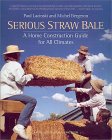 Serious
Straw Bale : A Home Construction Guide for All
Climates (Real Goods Solar Living Book.)
Serious
Straw Bale : A Home Construction Guide for All
Climates (Real Goods Solar Living Book.)
by Paul Lacinski, Michel Bergeron
T his book provides the metaphorical nuts and bolts of straw bale construction for homes and other buildings. Unlike many other straw bale construction books on the market, this one looks at building design issues from the perspective of the straw bale builders and considers the particular needs of the medium. Several different techniques are discussed, focusing much information on the needs of those building in wet and/or cold environments. Many illustrations, some color, and several project profiles demonstrate the theories discussed. Book News, Inc.®, Portland, OR
 Buildings of
Earth and Straw : Structural Design for Rammed Earth and Straw
Bale Architecture
Buildings of
Earth and Straw : Structural Design for Rammed Earth and Straw
Bale Architecture
by Bruce King, Ann
Edminster, (Editor)
C helsea
Green's The Rammed Earth House and The Straw Bale
House chronicle the possibilities and realities of straw bale and
rammed earth construction. Buildings of Earth and Straw
fills in the gaps for professional builders, contractors,
engineers, inspectors, lenders, and architectural students. It
includes special construction requirements of earth and straw,
design capabilities and limitations of these materials, and
documentation of testing data for use in addressing the concerns
of officials. This book offers the nuts and bolts of rammed earth
and straw bale building techniques, and why they are so
spectacular, durable, and earth-friendly. Straw bale and rammed
earth construction techniques are enjoying an explosive growth in
interest in the USA and worldwide. Previous Chelsea Green
publications such as The Straw Bale House and The Rammed Earth
House have shown the possibilities and realities of the
innovative forms of construction. Building with Earth and Straw
is the essential companion to both, providing technical data from
an engineer's perspective. Information includes the special
construction requirements of earth and straw, and the design
capabilities and limitations of these materials. Bruce King is a
structural engineer who has been involved in a variety of
innovative building projects. 140pp
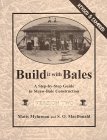 Build It
With Bales : A Step-By-Step Guide to Straw-Bale Construction,
Version Two
Build It
With Bales : A Step-By-Step Guide to Straw-Bale Construction,
Version Two
by S. O. MacDonald, Matts
Myhrman
THE BEST HOW-TO GUIDE AROUND
, March 12, 2000 Reviewer: Scott Christiansen from Hong
Kong, PRC
I highly recommend this book for anyone wanting to know
the basics of straw-bale construction. I have worked with the
authors in introducing straw-bale construction techniques in a
community-development context in Mongolia and China, and I can
say from first-hand experience that the authors know what they
are talking about (some designs from our Mongolia work ended up
in the book). In China, where my organization is working to
promote sustainable housing design, I use the book to explain to
government officials and others just what straw-bale construction
is all about. Because the illustrations are so clear, the book is
very useful in this context. I have passed out some 20 copies in
China so far, and have had requests for far more Build It With
Bales bridges the inspiring beauty of The Straw Bale House and
the technical authority of Bruce King's Buildings of Earth
and Straw (see below). This is the indispensable how-to book that
takes a designer/builder through the entire process,
step-by-step. The book is divided into two logical parts: Part
One: Before You Build: · Starting with bales · Three
basic approaches · Developing a plan; and Part Two: Building
At Last! · The Load bearing Option · The Non-load
bearing Option · Surfacing the Walls.
Liberally illustrated with clear, easy-to-interpret diagrams,
this book walks you through the building process sequentially,
from discerning the differences between hay and straw to applying
finishing touches on the wall surfaces. This is an essential
manual for any contractor or owner/builder specializing in bale
construction. 144 pp
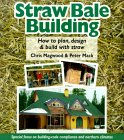 Straw Bale
Building
Straw Bale
Building
by Chris Magwood, Pater MacK,
Elisabeth Ohi (Illustrator), Peter Mack
S traw bale buildings speak to a part of us that insists that we should be able to build our own homes with our own hands. We look at pictures of a bale wall being raised and immediately think: I could do that! Straw bale houses are easy to build, inexpensive, super energy efficient, environmentally friendly, attractive, and - most of all - can be designed to match the builder's personal space needs, aesthetics, and budget. It's no wonder that straw bale houses are growing in popularity. Most straw bale books do a great job enticing us with beautiful photographs and "selling" the idea of straw-bale building - but they don't adequately address the most critical issues faced by bale house builders. In Straw Bale Building, professional bale builders Peter Mack and Chris Magwood lead the potential builder through the entire process of building a bale structure, tackling all the practical issues; from how to find and choose bales; developing sound building plans; costs; roofing; electrical, plumbing, and heating systems; building code compliance and working with building inspectors; and special concerns for builders in northern climates. For those who do not see their lives and their values reflected in "standard" homes, Straw Bale Building offers a wide variety of aesthetic and building options, from multi-storey luxury to elegant simplicity. Over 100 professionally illustrated drawings, plus b&w photos and building plans provide an abundance of creative and practical ideas for novice and experienced builders alike. Down-to earth and complete, Straw Bale Building makes the remarkable benefits of straw bale building available to anyone bitten by the straw bale "bug." Peter Mack and Chris Magwood are professional bale house builders. Together they have constructed 15 straw bale houses and structures. They teach a popular, on-going straw bale building workshop in Ontario, Canada.
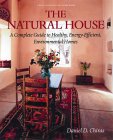 The
Natural House: A Complete Guide to Healthy, Energy-Efficient,
Environmental Homes
The
Natural House: A Complete Guide to Healthy, Energy-Efficient,
Environmental Homes
by Daniel D. Chiras
T his sourcebook examines the options for building a
house that is economical, energy-efficient, nontoxic, kind to the
environment, and pleasurable to inhabit. Explores the pros and
cons of 14 natural building methods, including straw bale, rammed
earth, cob, cordwood, adobe, earth bags, paper Crete, earth
ships, and others, all well- illustrated in b&w. Book News,
Inc.®, Portland, OR The author, Dan Chiras , July 7, 2000
The Natural House describes 14 natural building techniques.
When people ask me what, The Natural House is about, I say
"It's about creating sustainable shelter. That is,
it's about creating a dream home that is healthy, kind to
Mother Earth, nourishing to the soul, and easy on the pocket
book-not an environmental and economic nightmare." The
Natural House: A Complete Guide to Healthy, Energy-efficient,
Environmental Homes is really three books nestled comfortably
within the covers of one.
